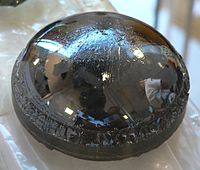
Photo from wikipedia
Abstract The growth of zinc oxide thin films with controlled nanostructures on the heat resistant dielectric substrates is important for the fabrication of gas sensors, transparent electric heating elements, pyroelectric… Click to show full abstract
Abstract The growth of zinc oxide thin films with controlled nanostructures on the heat resistant dielectric substrates is important for the fabrication of gas sensors, transparent electric heating elements, pyroelectric electron emitters, and many other potential electronic and optoelectronic applications. The preferred substrate for many of these applications is alumina, but the production of uniform ZnO layers on alumina is hindered by the large lattice mismatch between ZnO and Al2O3 hexagonal crystal structures. Here, we systematically investigate the growth process of ZnO thin films on alumina substrates using the ultrasonic spray pyrolysis (USP) of zinc chloride solutions in ethanol and, for the first time, demonstrate the deposition of uniform layers on the alumina substrates appropriately seeded using magnetron sputtering prior to USP. On the pristine substrates, random nucleation of the isolated nanocrystallites results in uneven layers, and extending the growth process leads to the hierarchical growth of facetted ZnO nanorods and pyramids with weak physical attachments to the substrate surface. In similar conditions, USP deposition on the seeded substrates reproducibly results in continuous networks of densely packed ZnO crystallites intimately attached to the substrate surface with adjustable thickness and electrical conductance. These results are compared with those obtained for SnO2 in similar conditions. Regardless of its tetragonal crystal structure, SnO2 reproducibly forms even layers on the pristine alumina substrates.
Journal Title: Ceramics International
Year Published: 2020
Link to full text (if available)
Share on Social Media: Sign Up to like & get
recommendations!